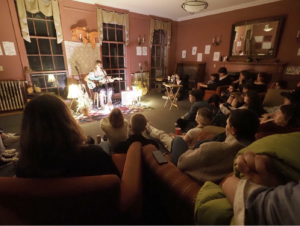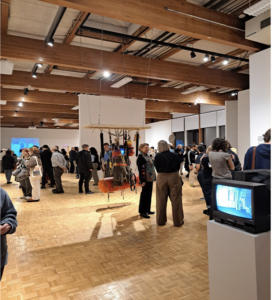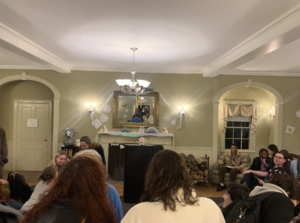Teju Cole, in describing the way a curtain hangs in one of the many German hotel rooms he has inhabited, describes the creases in the fabric as “the divine enfolded in skin.” He sees, in the simplicity of the fabric, an enriching power of the self rooted in the body—the way it bends and creases, at rest and motion simultaneously, expands, contracts, inhales, exhales. A self-supporting system in an imbroglio of entangled systems stitched together to create a curtain, a swath of cloth, cut from other cloth, made from other threads and folds, bendable, luminescent. A creator of light and shadow alike. It blocks the all-mighty glow of an imposing sun; it enshrines the human spatially in a cocoon.
He finds, then, in this fabric, the power humans have over themselves; a seemingly divine power that, when pushed from the inside out, swells into being. The ordinariness of the human, the specificity of the lives they live, the vitality of their self-hood, the richness of their efforts, are endowed by themselves with power.
Madeline Miller’s book Circe bears conceptual similarities; in the nuances of its mythos it enfolds the electric, kinetic capabilities of our humanity in the self-made, effortful portrait of Circe, a witch who—through the tenacity of her own desires—swells into a power of her own construction.
In the book, Miller gives an epic retelling of Circe’s mythical legacy; sprung from the shadow of the space outside the page, she pieces several stories together—Odysseus’s journey and death, the tale of Telemachus, the Trojan War, amongst others.
Circe, daughter of the Titan Helios, banished to the island Aiaia for turning a nymph—Scylla—into a hulking monster, struggles with the loneliness of exile, the cruelties of men, the fears of motherhood, and the immeasurable journey of growing old and strong in her own skin (mostly while she is alone, as the world unfolds around her). To summarize the book would be to reconnect the stories which hold Circe as a unifying thread (the plight of Medea, the odyssey of Odysseus, the birth of the Minotaur and its labyrinth, all stack atop each other as moments testing the power, resolve, and affection of a witch growing into the vibrancies of her power).
Despite the fact that the book is structured in this long-winding, seemingly patchwork sense, rooted in the interiority of a character locked in perpetual stasis reaching outward into the world through the people she encounters, Miller colors the text with a vibrant, electric, and archaic voice, rich in the translatory power of the ancient myth, but rooted in the familiarity of the human.
For instance, when her son—Telegonus, son of Odysseus—asks her permission to leave the island, Circe is upset. Athena has placed a threat upon her and her son, vowing to take him for her own in an act of revenge against Odysseus. In an attempt to keep the goddess at bay, Circe cloaks the island in magic; a spell to hide the island, another to keep Athena away, a dual concoction tied to Circe’s own person and life force, an extension of herself in divine form, an exhausting effort, especially in its early creation, as the unruly baby Telegonus challenged her will. Now, her only son, who for sixteen years has been by her side and poses as a sliver of the man she fell in love with within the years past, seeks not only to leave her side but to step head-first into death. “For sixteen years,” Circe fumes, “I had been holding up the sky, and he had not noticed. I should have forced him to go with me, to pick those plants that saved his life. I should have made him understand all I had carried in silence, all that I had done for his safekeeping” (Miller 272).
Here, Miller places Circe at the center of a web. Around her rests her son and his ambitions, the spell protecting them both from an all-powerful threat, the effort of that magic, the toil of working and stitching the spell together from the earth to make the enchantment—an entangled thread being pulled loose from Circe’s fingers. This tension, however, is not inhibitory; rather, it allows Circe to grow into herself further—she eventually allows Telegonus to go, outfitting him with an all-powerful weapon—the tail of Trygon, whose venom kills even gods upon contact—which she acquired by facing Trygon himself, prepared to bear eternal pain for the sake of her son (she comes out unharmed).
This network defines the intensity of Circe’s journey. She is poised against a heap of conflict that rests outside her agency (i.e. the threat of Athena, the notion of eternal pain to save her son,) and enshrouds herself in a power born from the vitality of her own personhood. It is not an outside entity from whom Circe derives her power, nor an abstract divinity; she weaves spells from the toil of work, cultivating the earth, communing with it to produce a reaction through a kind of symbiosis. It moves, from the inside of her body outwards, in congruence with the earth, not in a binary dynamic, but a shared, collective. Likewise, in the face of certain pain, she steps forward to accept its weight from Trygon for her son, a sacrifice that she did not have to make, because the notion of the act itself was enough to sway him. In other words, Circe, by the fortitude of her own resolve, creates her own power, and uses it to denature the forces around her that meddle in the vitality of her life and love. No one can harm Telegonus; how could they, against a figure, a mother, engulfed by the vitality of love, found within herself, and given manifestation in the physical earth through magic?
Circe pours power from within herself, formalizing it in her decisions and her magic, creating a network with the outside world—including its conflicts—that is enriched by her own femininity, her own motherhood. In a world that seeks to strangle her power as a woman, she—in an act of divine resiliency—crafts its antithesis.
As a result, Miller constructs a story that, with its mythical form, is able to bend itself into new angles, that it may prismatically produce new bursts of light. Circe is reworked from a figure of antagonistic sentiment to a nuanced, rich, and complex character, tangible, vibrant, and electrified by the sheerness of her humanity, by her proximity to us as readers. Mythos, here, is a film, a medium, on which Miller has painted a figure of self-making power in the form of Circe.
Her prose behaves in a similar fashion. Miller’s prose is active, spiced with the same effort of Circe’s resolve: “I cupped my own hands in the dark,” Miller writes, “ I did not have a thousand wiles, and I was no fixed star, yet, for the first time I felt something in that space. A hope, a living breath, that might yet grow between” (226). From this void, the ethereal miasma of existence and nonexistence, the eternal “middle ground” within which we intersect and translate ourselves and the world around us, Miller stitches together a narrative bound by other narratives, a story folded within stories, exhuming a rich, resonant voice from between the blank verse of classical texts.
Her prose, at once incantatory and catalogic, capable of erupting with kinetic force to catalyze the story into motion (I tremble at the cosmic, hulking mass of tentacles Scylla spills from her body to halt Circe’s journey to Minos,) and likewise calm, tranquil, a miasma of image and sensation, of plants and vines swimming before her eyes, dirtying her hands, latching beneath the beds of her nails, clinging to nest-like hair. It is more than illustration; the book moves fluidly as a paintbrush, gliding with tenacity before slowing at the minute details that define and enrich the piece itself.
As a result, Miller’s book is rich with a self-creating vibrancy, a woven, viscous tapestry. It is shaped, like clay, from the effort of her own hands, just as Circe creates her own cosmic power, reaching into herself, into the earth, “elbow deep” at times to pull from the “divinity enfolded” in her skin. The book is Miller’s own testament to this work, and is as powerful, spellbinding, and moving as the sacrifices her Circe makes, as the power she makes from the calluses of her well-worn hands.





Be First to Comment